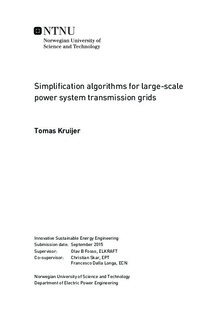Simplification algorithms for large-scale power system transmission grids
Master thesis
Permanent lenke
http://hdl.handle.net/11250/2368104Utgivelsesdato
2015Metadata
Vis full innførselSamlinger
- Institutt for elkraftteknikk [2497]
Sammendrag
The simulation of large-scale power system models including transmission gridrepresentations is limited by available computation power and time. Therefore, thereduction of transmission grid models is of paramount importance. This report proposes andtests a new method of reducing power grids. This method allows to reduce an existingtransmission grid model to any desired size, however, at the cost of accepting increasinglevels of inaccuracy.An algorithm is developed that reforms the total number of nodes in the full gridrepresentation into a smaller number of clusters, which are then connected by equivalentpower lines. The algorithm is designed in such way that those power lines remain in thetransmission grid that are likely to form a bottleneck, thus restraining power flows.The accuracy of this method is measured by comparing the power flows in the reducedpower grid to the flows from the original grid. The power flows of the full and reducedmodel are calculated by applying linear approaches based on PTDF matrices. PTDF matricesare commonly used in transmission grid analysis, linking node injections to power flows. Thepower flows are calculated based on a pre-defined set of injections, which represent cases of realistic power plant dispatches. The PTDF matrix for the reduced matrix is derived with the method proposed by Shi et al. The reduced matrix is operating point dependent, basedon a set of reference injections.The results show that every country can be reduced up to 37.5% of its original size, whenmaintaining an allowable error of 20% of the available transfer capacity of a power line.Most countries can even be reduced further before they exceed the set accuracybenchmark.In addition to this, the report researches whether guidelines can be identified to whichextend power grids can be reduced within preset limits of accuracy. Power grids in countrieshave different properties like topologies and grid characteristics, possibly leading to differing error behavior. The results show that no clear relation can be identified between the properties of a country s power grid and its error behavior, but is dependent on case specific situations in which node injections play a particularly decisive role. As the node capacity and node generation are random though, so are the occurring errors.Finally, the relation between accuracy and gained computation time in optimizationsimulations is identified. The relation between the number of variables in an optimizationmodel and required computation time is exponential. This relation shows that withoutexceeding the preset boundaries of accuracy significant gains in computation time can beacquired. A grid reduced to 22.5% of its original sizes does not exceed the error limit inpower lines, while the computation time reduces by a factor of 261.
